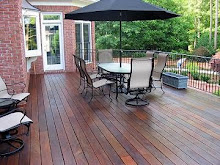Prevent Cupping for an above ground deck, observe these few simple steps:
• Be sure that the soil under the deck slopes away from the house and does not leave any contours that may puddle;
• Cover the soil with a vapor barrier which will prevent moisture from accumulating;
• Don’t allow any joists to contact soil (or lay flat on concrete if deck is built over an existing concrete patio). This will prevent moisture from wicking into boards, which will cause the decking boards to cup;
• Don’t allow any debris to accumulate under the deck which will hold moisture;
• Be sure that there is ventilation and sufficient clearance for air to flow from side to side under the deck – this is the most common cause of cupping;
• Standard S4S (not T&G) decking boards need to be installed with gaps between them. The gaps between PT boards will increase dramatically as the boards dry out while the gaps between Brazilian wood ipe decking boards will increase very slightly;
• Avoid fastening deck boards to any flat support that is more than half the width of the decking boards. If this is necessary, kerf and wax or finish the bottoms of these decking boards lengthways before installation.
Prevent Cupping when installing any type of ceiling under deck designed to create a dry living space underneath the deck. These caveats above should be observed and here are a few additional tips:
- Of course, this “dry below” system should slope AWAY from the house;
- It needs to be made of a material that will not hold moisture like aluminum or plastic;
- The below ceiling should be suspended below and not in direct contact with deck joists or otherwise designed so that the deck joists are not in contact with standing water. This will prevent the joists from wicking up moisture. Rainaway.com offers a system that is engineered to achieve this moisture control;
- Ample ventilation and air flow from front to back AND side to side under the decking boards is crucial and sometimes difficult to engineer given the small amount of clearance available;
- Small vents along the house in the deck boards or the ceiling can aid ventilation;
- We also recommend bottom kerfing (grooving) the boards with 3 grooves (for 5.5" boards) equal distance apart from one end of the board to the other and half the thickness of the board deep. This will prevent the boards from having the muscle to cup.
Cupping versus Warping - Cupping is not caused by inadequate drying while manufacturing the decking boards. Cupping is caused by moisture trapped below decking boards. Inadequate drying of decking boards will cause warping. Warping and twisting of boards occurs as the boards’ internal moisture content acclimates to their new climate. The solution to this dilemma is to replace the boards.
Other Factors That Affect Cupping - Cupping is not unique to any particular wood species however varying densities of different woods and board thicknesses are factors. Thicker deck boards are more susceptible to cupping than thinner boards – this is why kerfing the bottoms of boards is effective. Denser decking boards like Brazilian wood ipe decking do not absorb moisture as easily as other boards and therefore don’t cup as easily. This is also the reason why soft woods like pine display large rot-causing cracks when they weather while hard Brazilian decking (like ipe, cumaru, jatoba, tigerwood and others) only displays small check marks. These check marks do not affect the structural integrity of these very hard woods.
Remedies For Cupping - Sometimes cupping can be remedied by removing the cause – getting rid of the moisture. However, it is most often necessary to remove the decking boards, stack them flat using spacers providing adequate ventilation devoid of moisture and let them dry out. While they’re drying, you can be fixing the cause of the moisture while providing the correct conditions for the joists or other moisture holding supports to dry out too.
Courtesy Brazilian Wood Depot – Go Natural !


3 comments:
[color=#5588aa]Interesting post! thank you for sharing this information. bwdepot.blogspot.com really got under my
[/color] [url=http://nuscin-online.info]skin,[/url] [color=#5588aa]bookmarked... Keep up the great site...[/color]
Great tips, many thanks for sharing. I have printed and will stick on the wall! I like this blog. Wooden Window Beading Replacement
If a moisture problem has been corrected under the deck, and the boards are put down with nails so cannot be easily removed, can the cupped edges be sanded to smooth the deck? Have Ipe deck with small upward edges on some boards. Thank you!
Post a Comment